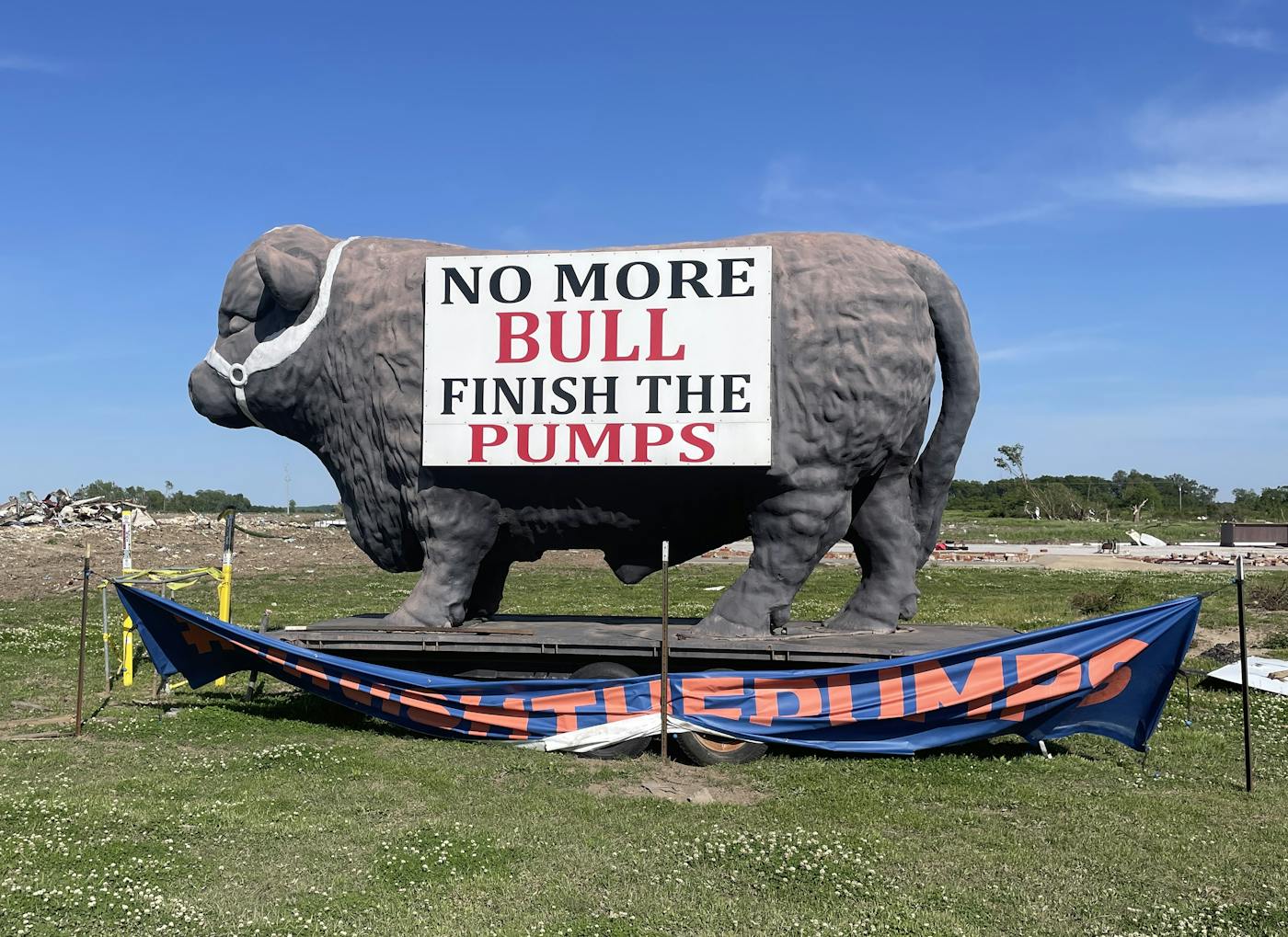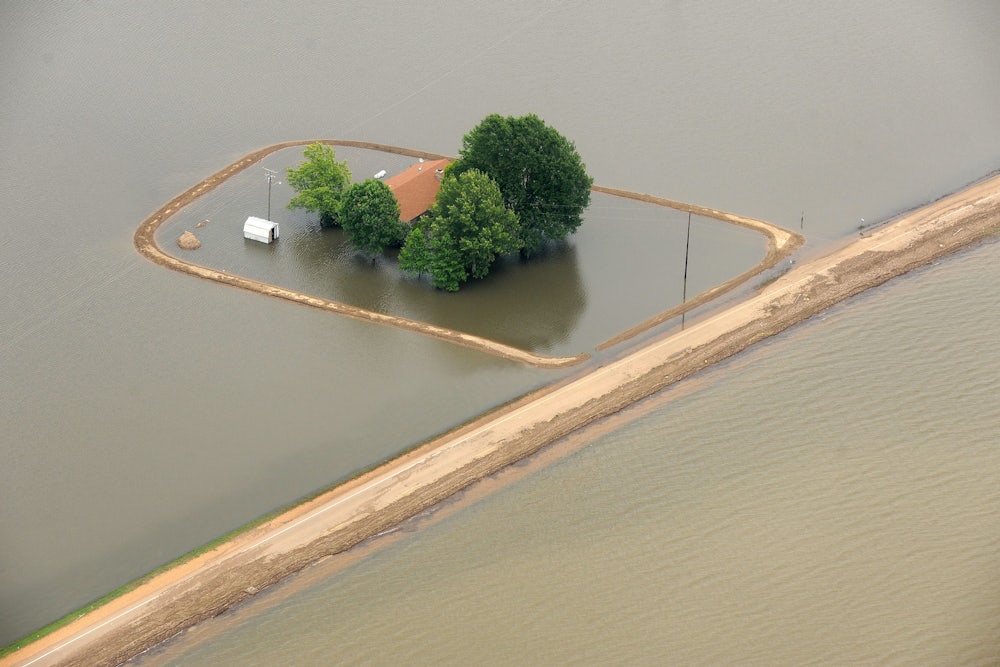The wreckage stretched for miles from where Chuck’s Dairy Bar once stood in Rolling Fork, Mississippi. About five weeks before my visit in May, a tornado had ripped through, killing 17 people there and in the surrounding area and destroying swaths of this small town. On the restaurant’s plot fluttered an American flag, alongside a sign advertising Federal Emergency Management Agency disaster assistance. Looming nearby was a roughly 11-foot-high statue of a bull with a sign on its side: “NO MORE BULL. FINISH THE PUMPS.”
The slogan refers to the Yazoo Pumps, a federal project first authorized by Congress all the way back in 1941 to pump floodwater out of this sparsely populated part of the Mississippi Delta, known as the Yazoo Backwater, which routinely floods low-lying farmland. Less common are devastating floods like the infamous one in 1927 that displaced around 640,000 people across multiple states and prompted the passage of federal laws such as the one authorizing the pumps. Although the Army Corps of Engineers installed vast flood-control infrastructure in the backwater and elsewhere in the Delta, the pumps still haven’t been built. But the Biden administration has resurrected the project: While I was in Mississippi, the Corps and the Environmental Protection Agency declared they want to build the pumps, with the Corps promising to deliver an assessment this month. That, in turn, has reignited warring sides in a long-running debate that draws on deeply rooted tensions around race and class in this stretch of the Mississippi Delta.
The pumps would drain as much as 16 billion gallons of floodwater a day out of the area, but environmental groups have long opposed the plan because of its potential to empty much of the area’s last wetlands. There are also concerns that the project’s cost—which opponents say could top $1 billion, and which the Corps declined to estimate in response to my queries—might not be the best way to invest in the Delta, one of the poorest regions in the country. While pump supporters regularly frame their case in terms of economic, environmental, and racial justice, the project would disproportionately benefit white landowners.
Since the tornado was not accompanied by flooding, the bull and its message have rankled some in the community. “That tornado hit on March 24, and about 72 hours later that bull was placed right in there in that town in the middle of all that destruction, promoting that phrase, ‘Finish the Pumps,’” said Ty Pinkins, a local attorney who’s challenging Mississippi’s Republican Senator Roger Wicker for his seat in 2024. Pinkins said the pump supporters used the tornado as “an opportunistic moment” to “place that message in the middle of all that, instead of using that energy to uplift community members.”
A white farmer with a 6,500-acre agricultural operation owns the bull. Its placement in the days after the tornado—in a town where 81 percent of residents are Black—is symbolic of what critics say is the area’s white farming elites’ cynical efforts to advance their own interests by suggesting the pumps will primarily benefit Black residents.
The two counties that make up the vast majority of the backwater, Sharkey and Issaquena, are 70 percent Black. Their poverty rates are significantly higher than Mississippi’s average, and more than triple the national average. Last May, the census identified them as two of 341 counties nationwide characterized by “persistent poverty.”
“The region’s unique history of slavery,” the U.S. Commission on Civil Rights stated in a 2001 report, “with its debilitating legacies—the sharecropping system, Jim Crow laws, the concentration of wealth in the hands of a minority white population, the political disenfranchisement of blacks, and the nearly total social segregation of the races—has been well documented and is generally viewed as the most significant factor in the region’s present position as among the poorest, if not the poorest, section of the nation based on virtually every socioeconomic measurement.”
Pump proponents tend to focus on contemporary poverty in the Delta and ignore the historical reasons for its persistence. “Talk about an environmental injustice,” Mississippi’s Republican Senator Cindy Hyde-Smith said in a 2022 congressional hearing after the EPA reasserted a 2008 veto of the pumps: “This is a true minority community who live in true poverty.” These arguments have gained traction within the Biden administration, as the announcement last May attests. But it’s far from clear how much the pumps would actually benefit the area’s Black majority.
One Army Corps analysis found that 80 percent of the pumps’ financial benefits would flow to farmers (the prevention of damage to roads and other infrastructure makes up most of the remaining 20 percent). But after decades of discriminatory lending, racist government policies, outright theft, and industry trends hostile to small farms, many Black Delta farmers have been pushed off their land. At the beginning of the twentieth century, according to historian John C. Willis, two-thirds of farm owners in the Delta were Black; today, 92 percent of agricultural producers in Sharkey County and 87 percent in Issaquena are white. Black farmers are even being pushed out as farmworkers (and moreover, the EPA cautioned in 2008 that the pumps could worsen job prospects for farmworkers).

The case for the pumps was reenergized in 2019 after a devastating flood lasted over six months, putting 231,000 acres of farmland underwater and damaging hundreds of homes and other buildings. Two people drowned when their car drove off a road into floodwaters. The Delta Council—a business group advocating for farming interests, of which the owner of the Rolling Fork bull is a board member—and some residents of a small, majority-white community banded together to promote the pumps by meeting with Mississippi’s senators, launching a pro-pumps website, and coordinating turnout at community hearings. They’ve been joined by the Army Corps’s official local government partner, the Mississippi Levee Board, which has long focused on helping the area’s agriculture industry.
In a 2021 press release supporting the pumps, the Levee Board said more than 90 percent of homes lost in the 2019 flood “were owned by our Black and Indigenous people of color (BIPOC) neighbors.” But Mississippi Emergency Management Agency data analyzed by environmental groups, as well as local reporting, appears to contradict that claim. The data shows the bulk of housing flood claims came from Warren County, of which only a sliver is inside the Backwater. While Warren County’s white and Black populations are nearly even at around 49 percent, Eagle Lake, the county’s largest community of around 300 people in the Backwater, is over 90 percent white.
The Levee Board walked its claim back when I filed an open records request for data or evidence to back it. In a written response, the board’s attorney described the buildings not as “homes” but as “structures.” Unlike the board’s press release, he described them not as BIPOC-owned or occupied, but rather as located “in minority areas.” He told me the Levee Board based the claim on verbal remarks by an Army Corps official in 2021 who “did not provide written documentation related to this assessment of minority ownership.” The Army Corps did not answer questions.
“It really is quite shocking that the Biden Administration would propose this project,” Pinkins, who is Black, wrote in a June letter to the Corps and EPA, “since its true purpose is to help already rich farm owners get even richer by planting more crops on their large low-lying farms while the needs and requests of Black community members continue to be ignored.” In a follow-up letter in August, Pinkins was joined by 49 other community members in opposing the pumps.
It’s worth noting that many Black community members do support the pumps, and some—like Tracy Harden, owner of Chuck’s Dairy Bar—make environmental justice arguments for them. But it is far from clear whether the few Black-owned farms left in the area would benefit more from the pumps than from other flood mitigation measures. And backwater towns like Rolling Fork, where most of the area’s Black majority live, generally do not get flooded since they are built on higher ground.
“If you want to help folks in that area needing flood protection, you don’t need pumps to do it,” said Leonard Shabman, an economist with the nonprofit Resources for the Future. Shabman, who has served in government roles examining Army Corps projects, studied the issue for the EPA two decades ago. For far less money, he said, roads and homes can be elevated and more levees can be built.
In fact, the pumps could make things worse for some Black residents. The water pumped out of the Yazoo Backwater will exacerbate flooding downstream in a flood-prone, majority-Black neighborhood on the north side of Vicksburg. The Corps says the added risk is negligible. However, an expert consultant hired by environmental groups found the Corps’s model of downstream impacts so flawed it “cannot be trusted.”
Ideally, the federal government would resolve these debates. The Army Corps is assessing the project, saying it has committed to conducting “meaningful outreach to communities with environmental justice concerns.” Its findings, which should offer a clearer picture of whom the pumps would benefit, are expected to be unveiled this month. But the EPA found major shortcomings with the Corps’s last two environmental justice assessments, including “insufficient data” to address the project’s benefits and a “lack of an adequate evaluation” of possible harm to downstream communities.
The Army Corps’s past attempts at community engagement raise questions about how successful the outreach will be. The Corps did not mention any interviews with community members in its most recent environmental justice assessment in 2020. A 2007 assessment includes interviews with only 16 people. “Because the Yazoo Backwater Area is largely rural, individual interviews were difficult,” it said.
Insufficient outreach isn’t the only problem. At an August 2022 listening session in Rolling Fork, the aggressiveness of some pump supporters led to accusations of intimidation. Black and white attendees expressed a range of views, mostly supportive of the pumps. But according to Charles V. Taylor Jr., the executive director of the NAACP Mississippi state conference, “When people spoke against the pumps, the majority-white crowd heckled them.… There was a lot of profanity, anger.”
Taylor’s organization does not take a position on the pumps themselves. But he raised his concerns earlier this year with Mississippi’s Democratic Representative Bennie Thompson, and it’s clear they’re known to the Army Corps: Mike Connor, an Army assistant secretary, acknowledged as much when I spoke to him. I asked him if he thinks the Corps has had sufficient engagement with members of the Black community. “I will never say we’ve heard enough, and we are keeping the doors open,” he said. But there were only a handful of Black community members in the audiences at two listening sessions I attended in May.
Louie Miller of the Sierra Club and the Audubon Society’s Jill Mastrototaro are among the most visible opponents of the Yazoo pumps. Both are white. They also documented problems during the August 2022 Rolling Fork meeting. In a letter to the White House’s Council of Environmental Quality, which convened the event, they said one of them was “accosted by a drunk audience member that required the intervention of two law enforcement officers.” They said a police officer took “the initiative to escort us safely out of the building.”
A Vicksburg Post article also notes law enforcement escorted Representative Thompson out of the building. Thompson has staked out a careful position on the pumps, calling on the government’s decision-making to be driven by science and the law. He has been criticized online by pump supporters, and Senator Hyde-Smith said in 2021 that “Thompson destroyed this project.”
The Rolling Fork meeting was not the first time that pump supporters have lashed out at opponents. Even a local small-business owner well connected in state GOP politics has faced hostility for opposing the pumps. During the 2019 flood, pump supporters boycotted a store owned by William Van Devender, a white member of the fundraising committee of Tate Reeves’s first (and winning) campaign for governor. Van Devender had opposed the pumps in a letter to a Corps official, urging economic development of the area instead.
Nonetheless, some locals are still speaking out. “For decades, the Yazoo Pumps has been held out as the promised solution to flooding in our counties and the rest of Mississippi’s Yazoo Backwater Area,” wrote Pinkins and 49 other community members this August, “but we are not fooled.”
This story was produced in partnership with the Project on Government Oversight, or POGO.








